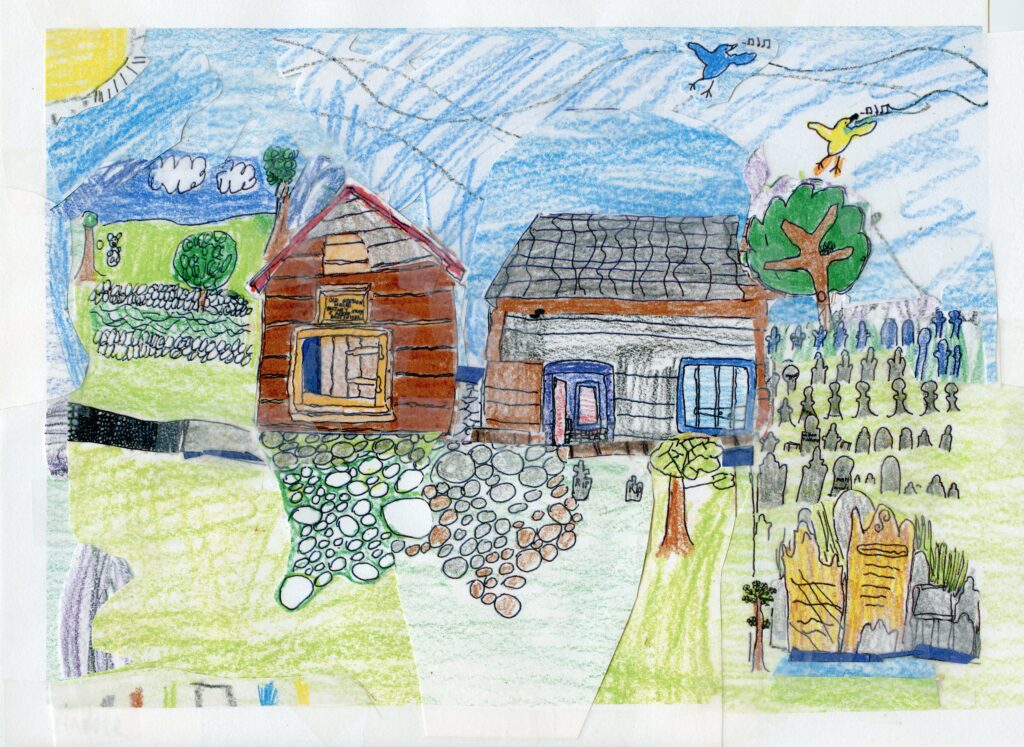Weekly Article
Courtney McKinney-Whitaker • Derry Member
February 8, 2024
Over the past several months, Jill Peckelun and I have had the privilege of working with Derry’s 3rd-5th graders on a picture book history of Derry Church. We are often joined by Pam Whitenack, who answers many questions about Derry’s history on the spot, and Kristy Elliot, who provides student support.
Plans for this project emerged last year as the Derry 300 Committee imagined ways to include children’s voices in the Derry 300 celebrations. During the 2023-24 program year, Jill and I have met with an average of about ten children per week during Creation Time on Tuesday evenings to write and illustrate the story of Derry Church.
We decided to tell the story through the evolution of Derry’s physical space. 3rd-5th graders are just developing the capacity for the kind of abstract thought that deep study of history requires, so we decided to connect all the abstract names, dates, and ideas to a space they already knew well and now know even better—their own church.
We divided our project into several topics. So far we have written and illustrated pages about the Session House, Spring, and Cemetery, Old Derry, and the John Elder Memorial Chapel. Jill and I have developed the following process for researching, illustrating, and writing about each topic.
First, we do a site visit to a relevant location in the church to draw from life, or we draw from pictures in Derry’s archives. Jill takes the children’s sketchbooks and painstakingly selects images from each of the children’s drawings to create a composite collage. Next, the children use crayons to add color to the composite image. Jill then repeats the process, creating the final image by scanning and collaging the color images. We’d like to thank Sue George for lending her technical expertise to aspects of this process.
Through this process, I’ve been able to introduce some of the concepts of historical work, including primary sources (those contemporary to the period under study) and secondary sources (those created later from primary sources). Primary sources used on this project include photographs, artifacts, and of course, the building itself. For our secondary source, we rely on Bobbie Atkinson’s April 27, 2023 Long Read, which details the history of our buildings. We begin our study of a particular topic by reading the relevant portions of this article to get a general overview, and we revisit it throughout our study.
To produce the text, I begin by listening to the children talk as they work. Sometimes I ask them questions about what they are drawing and why. I note what they tell me. Toward the end of the process, I ask, “What did we learn? What do we feel is important for others to know?” I note that down, too. Finally, I take all the language they have given me and shape it into a narrative.
My star word for 2024 is delight, and it has truly been a delight to work on this project. Here are a few of the standout moments:
- Taking the children outside to sketch the Session House, Cemetery, and Spring. It was such a blessing to hear their kind words for the saints resting in our cemetery, those they knew and those who lived long ago. Several of them asked if there was any way to go inside the Session House, so we are working on possibilities for taking them in one or two at a time when it is safe. I have learned that kids love the Session House! (It’s a little house under glass in the parking lot. Who wouldn’t?)
- Participating in a Tuesday night worship service. In November, Pastor Stephen led a Tuesday evening worship in the Chapel with communion. The kids sat around the chancel to sketch the artifacts that remain from Old Derry, including furniture and the pewter communion set.
- Watching the kids get so excited about artifacts from the Heritage Room! We meet in Room 6, which is conveniently located next to the Heritage Room. It was such a joy to see the kids show so much interest in the various objects Pam Whitenack pulled out one evening and debate with each other and us about their possible uses.
- Helping a table of kids study images of the Chapel to put them in chronological order—an activity they began spontaneously out of their own interest.
- Meeting with a small but dedicated group the night of a snowstorm to tour the chapel with Pam and ring the bell.
It’s not often in life you realize you’re doing one of the most important things you’ll ever do while you’re doing it, but I have experienced that feeling while working with these children on this project.
Jill and I are often astounded by the children’s work, by their wisdom and talent. Looking with new eyes, they often show us things we missed. I hope that the children who work on this project will take the skills and confidence and knowledge they’ve gained into whatever they do next and into their eventual vocations. I don’t call this a children’s book, because it isn’t just for children. It’s a picture book, and picture books are for everyone.
You’ll have your opportunity to pre-order this one in the spring. In the fall, we will celebrate the book’s arrival with a book launch party at a special post-worship fellowship.
Thank you for your support of the children and this project. To learn more, check out the bulletin board across from Room 6 or ask a 3rd-5th grader about their experience. We look forward to sharing the book with you.